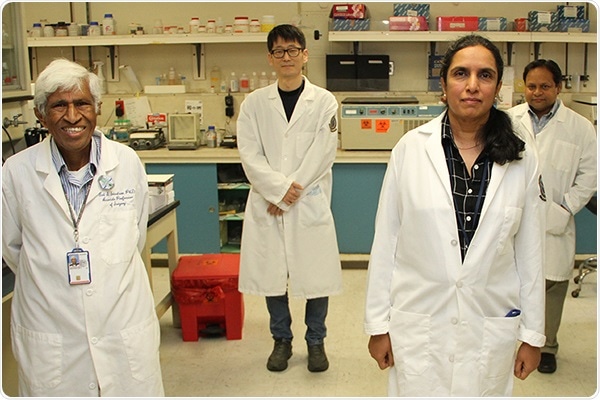Scientists from the University of California, Los Angeles have discovered a promising diagnostic marker that may help predict the response of cervical cancer patients to standard radiation and chemotherapy treatments.

Front row, l-r: Senior author Eri Srivatsan and first author Mysore Veena. Back row: Additional authors Sanghoon Shin and Saroj Basak. Image Credit: University of California, Los Angeles Health Sciences.
The researchers observed that a gene, called PACS-1, residing on a small portion of the long arm of chromosome 11, is highly expressed in cancer tissues, potentially leading to the growth and spread of cancer.
They also found that translocation of the PACS-1 protein from exterior to the interior of the cell nucleus—a function required for the normal growth of cells—plays a crucial role in the development of cervical cancer that is impervious to radiation and chemotherapy.
According to the researchers, higher concentrations of PACS-1 expression in the nucleus could signify resistance to the treatment.
Background
Globally, cervical cancer is the second leading reason of cancer-related mortality in women. Although infection with human papillomaviruses also plays a major role in the development of cervical cancer, the presence of a virus is not adequate to cause cancer; environmental and genetic factors, like poor eating and smoking habits, also play a major role. Hence, biological markers should be identified as targeting agents for diagnosing and treating this condition.
Method
The team conducted a western blot method to detect particular protein molecules from among a combination of proteins, on healthy cervical tissue and cervical tumors and found that the PACS-1 protein is highly expressed in the tumor tissues. The researchers subsequently developed in vitro human cell line models to evaluate the function of the protein in cell growth.
They finally employed a fluorescence-activated sorter analysis to find out if the overexpression of the PACS-1 protein was linked to cancer chemoresistance.
Impact
If verified in animal studies, the use of the PACS-1 protein as a diagnostic marker could result in the development of therapeutic approaches to resolve treatment resistance in patients with cervical cancer. Alternative treatment methods, such as the inhibition of PACS-1 expression, could be employed along with the immune system–activating agents or chemotherapy.
Source:
Journal reference:
Veena, M. S., et al. (2020) Dysregulation of hsa-miR-34a and hsa-miR-449a leads to overexpression of PACS-1 and loss of DNA damage response (DDR) in cervical cancer. Journal of Biological Chemistry. doi.org/10.1074/jbc.RA120.014048.